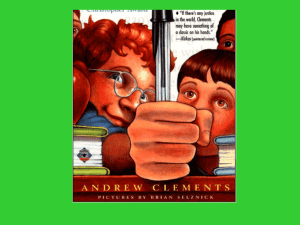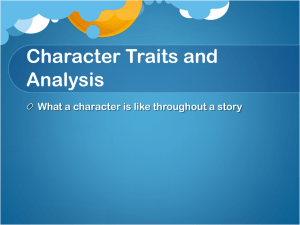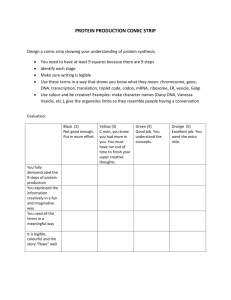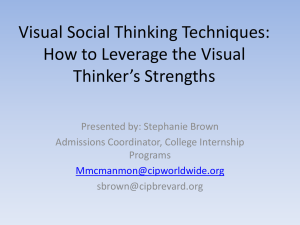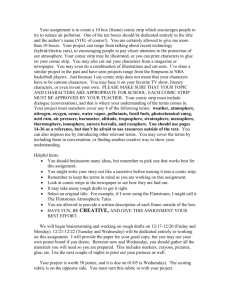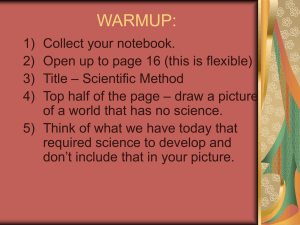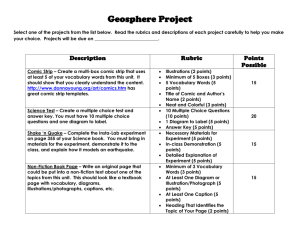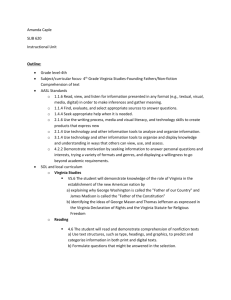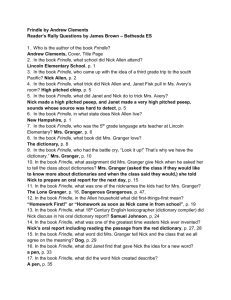Book Club Unit “Frindle”
advertisement
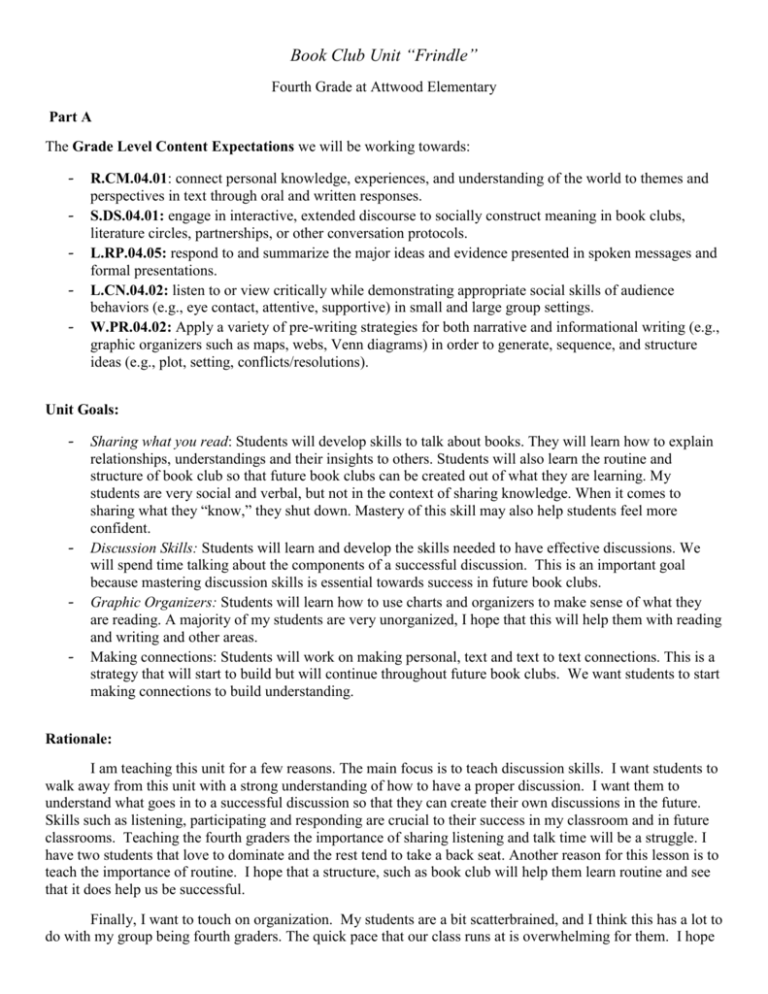
Book Club Unit “Frindle” Fourth Grade at Attwood Elementary Part A The Grade Level Content Expectations we will be working towards: - R.CM.04.01: connect personal knowledge, experiences, and understanding of the world to themes and perspectives in text through oral and written responses. S.DS.04.01: engage in interactive, extended discourse to socially construct meaning in book clubs, literature circles, partnerships, or other conversation protocols. L.RP.04.05: respond to and summarize the major ideas and evidence presented in spoken messages and formal presentations. L.CN.04.02: listen to or view critically while demonstrating appropriate social skills of audience behaviors (e.g., eye contact, attentive, supportive) in small and large group settings. W.PR.04.02: Apply a variety of pre-writing strategies for both narrative and informational writing (e.g., graphic organizers such as maps, webs, Venn diagrams) in order to generate, sequence, and structure ideas (e.g., plot, setting, conflicts/resolutions). Unit Goals: - - Sharing what you read: Students will develop skills to talk about books. They will learn how to explain relationships, understandings and their insights to others. Students will also learn the routine and structure of book club so that future book clubs can be created out of what they are learning. My students are very social and verbal, but not in the context of sharing knowledge. When it comes to sharing what they “know,” they shut down. Mastery of this skill may also help students feel more confident. Discussion Skills: Students will learn and develop the skills needed to have effective discussions. We will spend time talking about the components of a successful discussion. This is an important goal because mastering discussion skills is essential towards success in future book clubs. Graphic Organizers: Students will learn how to use charts and organizers to make sense of what they are reading. A majority of my students are very unorganized, I hope that this will help them with reading and writing and other areas. Making connections: Students will work on making personal, text and text to text connections. This is a strategy that will start to build but will continue throughout future book clubs. We want students to start making connections to build understanding. Rationale: I am teaching this unit for a few reasons. The main focus is to teach discussion skills. I want students to walk away from this unit with a strong understanding of how to have a proper discussion. I want them to understand what goes in to a successful discussion so that they can create their own discussions in the future. Skills such as listening, participating and responding are crucial to their success in my classroom and in future classrooms. Teaching the fourth graders the importance of sharing listening and talk time will be a struggle. I have two students that love to dominate and the rest tend to take a back seat. Another reason for this lesson is to teach the importance of routine. I hope that a structure, such as book club will help them learn routine and see that it does help us be successful. Finally, I want to touch on organization. My students are a bit scatterbrained, and I think this has a lot to do with my group being fourth graders. The quick pace that our class runs at is overwhelming for them. I hope that providing them with tools to organize their thoughts and work will help them manage the pace of the class. I want to teach a variety of graphic organizers to the students to help them sort out their information. We recently did a “Go Map” organizer to help with writing summaries. After doing this, their summaries had improved along the lines of organization. Overall, my goal is to combine these three ideas to create a concise unit that will be a springboard into higher level ideas as the year goes on. Unit Overview: The week before we read students will start pre-reading the book. The Friday before class, October 29, I will ask students to read the first chapter. The reason for pre-reading is so that students have a smooth transition from MEAP to book club. We want to give students that week to make up MEAP tests and get MEAP out of their systems. Day 11.1 (1) GLCE R.CM.04.01 Connect personal knowledge, experiences, and understanding of the world to themes and perspectives in text through oral and written responses. Activity Introduce book club routine to students: - We will have discussions - We participate - We share our thoughts - We dig deep to understand the book - We will not read ahead a spoil the story These “We” statements will be posted during book club. Pass out Frindle Folders. This is to help students understand their reading and have focus questions during discussion. The folders have worksheets and loose sheets of paper already in them. Students can decorate their folder as they please. Read chapter 1 aloud. In case students did not read, I want them to be on the same page. This is also a great modeling review for everyone. Materials Frindle books Objective Focus: Introduce and Discussion Frindle Folders Students will develop a basic understanding for book club routines by listening to the rules and routines and asking when they are unsure of expectations. Assessment This is an introduction day; however, I will pay attention to how students participate in discussion. 11.3 (2) L.CN.04.02: listen to or view critically while demonstrating appropriate social skills of audience behaviors (e.g., eye contact, attentive, supportive) in small and large group settings. L.RP.04.05: respond to and summarize the major ideas and evidence presented in spoken messages and formal presentations. (chapter 2/3 hw) Ask them to come over to the carpet and start talking about chapter 2/3. (This should be a problem. The goal is for students to see that we need guidelines for discussion) Brainstorm in our journals “what worked and what didn’t work about our discussion?” If time: Have students shared their ideas. These ideas will be written on the white board We will watch the fifth graders have a discussion about their book Frindle books Look and Sound Like worksheet Frindle Folders Focus: Learning the components of discussion Students will break apart the components of a good discussion by interacting in a discussion and reflecting on their experience. Students will brainstorm what makes a good discussion by thinking about what a discussion looks and sounds like. How do students interact? Are they participating, sharing ideas? I will assess the above questions by taking notes; I have created a folder that I can take notes in during the book club about their participation and progress. Frindle Folder check – checking for work, not for correctness. After we watch the fifth graders, we create a chart including what does a discussion look like and sound like? Reflect on the discussion that we had, what worked there? 11.4 (3) L.CN.04.02: listen to or view critically while demonstrating appropriate social skills of audience behaviors (e.g., eye contact, attentive, supportive) in small and large group settings. L.RP.04.05: respond to and summarize the major ideas and Read chapter 4 (chapter 5 hw, Look and Sound Like worksheet) Discuss and compile Look and Sound Like worksheet. Ask them why we took the time to talk about discussion. The chart we create will be left up for all of book club. Review chapters 4 and 5 Make character chart Large piece Students will break of poster apart the paper components of a good discussion by Frindle interacting in a books discussion and reflecting on their Frindle experience. Folders Students will brainstorm what makes a good discussion by thinking about what a discussion I will collect the character charts. I am looking for completeness and the connections they made with their character. evidence presented in spoken messages and formal presentations. Connect to talk characters asking “Do any of the characters remind you of people you know?” looks and sounds like. Students will make personal connections to a character from the book to better comprehend. After students fill out their chart, they will share with their partner, THINK, PAIR, SHARE (chapter 6 hw, comprehension packet) 11.5 (4) 11.8 (5) W.PR.04.02 - Apply a variety of prewriting strategies for both narrative and informational writing (e.g., graphic organizers such as maps, webs, Venn diagrams) in order to generate, sequence, and structure ideas (e.g., plot, setting, conflicts/resolutions). L.CN.04.02: listen to or view critically while demonstrating appropriate social skills of audience behaviors (e.g., eye contact, attentive, supportive) in small and large group settings. L.RP.04.05: respond to and summarize the major ideas and evidence presented in spoken messages and formal presentations. Review chapter 6 Frindle books Work on Frindle Folder Make a chart of the main events up to chapter 6. Make predictions. Share predictions. Frindle Folders Read chapter 7 in class Connect with personal knowledge – go home and ask someone if used any made up words when you were little (chapter 8 hw) Warm up: Write about the made up word you used On a note card, write the made up word. On the back, write what it means. Discussion: Talk about our made up words. During discussion, we will toss a spool of yarn. This will helps students see who dominates discussion. Discussion Frindle books Frindle Folders Note cards Students will develop discussion skills by participating in Think, Pair, and Share. Students will use organizers to understand the sequence of events. I will pay attention to what students think are the main ideas. This will help me see if they Students will begin understand what to learn techniques they are reading. to help them sort If this is a out key events by challenge, I will reading critically talk to them about and sharing ideas the importance of with students. taking notes in their Frindle Folder’s and answering the discussion questions. Students will make This is another personal discussion I will connections to the take notes on. I text by coming up will compare the with their own notes taken in this made up word like discussion to the Nick. first discussion. Students will continue to develop their discussion skills as they talk about their made up word and the connections they have to it. should be a group effort. S.DS.04.01: engage in interactive, extended discourse to socially construct meaning in book clubs, literature circles, partnerships, or other conversation protocols. Students will understand that dominating the conversation if not an effective way to communicate by watching how the yarn travels. Reflect on the yarn. How did our discussion go? Read chapter 9 as a class. (chapter 10 hw) 11.9 (6) L.CN.04.02: listen to or view critically while demonstrating appropriate social skills of audience behaviors (e.g., eye contact, attentive, supportive) in small and large group settings. S.DS.04.01: engage in interactive, extended discourse to socially construct meaning in book clubs, literature circles, partnerships, or other conversation protocols. W.PR.04.02: Apply a variety of pre-writing strategies for both narrative and informational writing (e.g., graphic organizers such as maps, webs, Venn diagrams) in order to generate, sequence, and structure ideas (e.g., plot, setting, conflicts/resolutions, Students will understand the importance that everyone shares as we reflect and create sharing guidelines. Review chapter 10 and work on Frindle folders. Frindle books Introduce the story Mrs. Nelson. Frindle Folders Read aloud. Miss. Nelson is Missing Ask students to make connections with Mrs. Granger and Miss. Nelson. Make a Venn Diagram as a class. Share diagrams. Start chapter 11 (hw if not finished) Students will be able to make text to text connections to understand the story. Students will work with graphic organizers to sort out their ideas. I will collect the Venn Diagrams and check for completeness. Students are expected to fill out the diagram. I will also take notes on this discussion so that I can compare the way the talk about the character to past discussions. 11.10 (7) S.DS.04.01: engage in interactive, extended discourse to socially construct meaning in book clubs, literature circles, partnerships, or other conversation protocols. L.CN.04.02: listen to or view critically while demonstrating appropriate social skills of audience behaviors (e.g., eye contact, attentive, supportive) in small and large group settings. Introduce Fishbowl! Have students put chairs in a circle, explain the rules of fishbowl. Write the rules on the board. Frindle books Frindle Folders Tell them that this is a practice. We are going to try our best. Students will build and learn the skills that are needed to participate in fishbowl by watching how I model and by participating. This will be one of the discussions I take notes on. I will take notes on participation, whether their ideas are relevant and if they are following routine. Students will generate thoughtful ideas about the text by sharing with other students and by listening to other student’s connections and thoughts. There will be a list of prompts on the board for them to talk about. We will do this for 20 minutes. Discuss about what happened, what we saw. Time to read individually and fill out Frindle Folders. 11.11 (8) W.PR.04.02: Apply a variety of pre-writing strategies for both narrative and informational writing (e.g., graphic organizers such as maps, webs, Venn diagrams) in order to generate, sequence, and structure ideas (e.g., plot, setting, conflicts/resolutions. S.DS.04.01: engage in interactive, extended discourse to socially construct meaning in book clubs, literature circles, partnerships, or other conversation protocols. Chapter 12 and 13 Review Chapters 12 and 13 Frindle books Start working on sequencing. Frindle Folders What is sequence? Why is it important? It is similar to events. Comic Strip paper Introduce comic strip. Pick the 6 main events and create a comic strip. Show an example. Brainstorm the first main idea. Write main ideas on white board. Choose one as a class and create one of the comic strip squares. Give the rest of the time to work on the comic Students will use context clues, discussion and connections to sort of the key events of the story to create a sequence of events. Students will use the comic strip organizer to make sense of their information so it is easier for them to compile. I will assess the amount of work students were able to get done during the time. Were they working on sequencing the events? Did they get the draft for strip one and two done? strip. Let them know that the comic strip is due Monday, November 15. 11.12 (9) 11.13 (10) S.DS.04.01: engage in interactive, extended discourse to socially construct meaning in book clubs, literature circles, partnerships, or other conversation protocols. S.DS.04.01: engage in interactive, extended discourse to socially construct meaning in book clubs, literature circles, partnerships, or other conversation protocols. W.PR.04.02: Apply a variety of pre-writing strategies for both narrative and informational writing (e.g., graphic organizers such as maps, webs, Venn diagrams) in order to generate, sequence, and structure ideas (e.g., plot, setting, conflicts/resolutions. (hw chapter 14, Frindle Folder) Review chapter 14 Fishbowl Discussion. Talk about key points from chapter 14. Prompts will be written on the board. Frindle books Frindle Folders Continue work on comic strip. Read aloud the last chapter. Frindle books End up book club discussion. Frindle Folders Have students reflect on the book in their folder. Ask them to think about what they liked, how it ended, etc. Ask for thoughts about the book. Share ideas and have a mini discussion. Ask for unanswered questions. Give students the rest of the time to work on comic strips. Students will build and learn the skills that are needed to participate in fishbowl by watching how I model and by participating. Students will generate thoughtful ideas about the text by sharing with other students and by listening to other students’ connections and thoughts. Students will discuss about their reactions to the book and share their opinions with the group. I will compare how students did in the first fishbowl compared to the second. For the student reflection, I will expect a paragraph reflection on the book. Sample Lesson Plans: Discussions Start with Self Control Date: Day 5, November 8 Objective(s) for today’s lesson: - L.CN.04.02: listen to or view critically while demonstrating appropriate social skills of audience behaviors (e.g., eye contact, attentive, supportive) in small and large group settings. - Students will understand that dominating the conversation if not an effective way to communicate by watching how the yarn travels. Students will understand the importance that everyone shares as we reflect and create sharing guidelines. - Rationale: From past discussions in class, I have noticed that the amount of sharing in discussion is not equal. There are Materials & supplies needed: - Frindle Folders Spool of yarn Note cards Introduction to the lesson: (7- 10 minutes) “Last night, I asked you talk to your family about made up words you used when you were little. So for warm up, take five minutes to write about the word you learned about. What did that word mean, did other people use it?” Academic, Social and Linguistic Support during each event “Do not share your word yet, just write about it.” Students take five minutes to reflect on their made up word in their folder. I want them to have a time frame so they can balance their time. “Thank you, so today we are going to play with these words. I am going to give each of you a note card. On one side of the note card, write your word in big letters.” Wait for them to do this. Remind them of what they are doing. “Great, now on the back, write what the word means.” “When you are ready, put your pencil on your desk and look up.” “We have been building the skills that are needed to have a successful discussion. Today, we are going to put these skills into action.” “Let’s all pull our chairs into a circle, quietly please, and wait for the prompt.” I write my word to model, display it to the class. I write the meaning on the back of my note card. OUTLINE of key events during the lesson: (15 – 20 minutes) “Thank you for moving quietly and waiting. Today our discussion will be about our made up words. We will share where they came from, what they mean, and what they mean to us. Remember what you wrote in your journal this morning if you are not sure what to say.” Tell them how they should do the task. Wait for my words to sink in. “As we share, we are going to pass around this spool of yarn. The yarn travels to whoever is talking. For example, I have the yarn now because I am talking. Whoever talks after me, will get the spool of yarn. Now here is the catch, I will still hold on to a piece of the yarn. Does this make sense?” Giving them time to think. I do an example if they respond with confusion. “Alright, thinking hats on. Reflect back on what you wrote in your journal and your note card if you have a problem thinking of what to say.” “I will start, my word was ______. My parents said that I used this word when I was mad.” I pass the yarn and give students the opportunity to share their word. Giving them the time to think and make sure this makes sense. Model in case things are unclear. “Alright, great, so how successful do you think our words would be if we started using them now?” I pass the yarn again and watch the discussion. I chime in if there is a dull in the conversation or if we are getting off track. I give lead questions to help them in case starting a discussion is challenging still. “Great job! Alright before you share, take a look at the path the yarn took. Do you have more yarn then everyone else? Do you have less than everyone else? Closing summary for the lesson: (10 - 15 minutes) “Now that you had time to think, let’s talk about what happened.” “Did anyone have more string than others? Did anyone have less than everyone else?” Want students to reflect and think before responding. I let students share and respond. “Think about the look like, sound like sheet. Does only one person talk in a good discussion?” Wait for ideas and sharing. I hope that they have insight and a lot to share based on the way the yarn traveled. “Why do you think we did this?” Wait for ideas. Promoting ideas and discussion. “I think you guys did a really good job of participating and discussing today. As we build our skills, it is important that we remember how important it is that everyone talks in a discussion.” Want them to feel confident in what they did. If time, I will start reading chapter 8. Transition to next learning activity “Remember to read chapter 9 (or 8 depending on time) for homework. You should also fill out your Frindle Folder as you read along.” Assessment: Since the goals of this lesson are discussion based, I will be evaluating their performance in the yarn discussion and the reflection discussion. Remind them of what is coming ahead. Academic, Social, and Linguistic Support during assessment This will look different for everyone and it will be reflected in the way I take notes. For example, Logan, who Are they involved? (Do they look at the speaker, do they follow is Autistic, only has to share once in the conversation, and are their ideas building off others each discussion. thoughts?) Do they contribute effectively? (Are they dominating discussion, are they not sharing at all, have they at least shared 2 – 3 ideas?) Are they on task? (Are their ideas on task and relevant to the discussion?) I will take notes on three things: - Miss. Nelson vs. Mrs. Granger Date: Day 6, November 9 Objective(s) for today’s lesson: - - R.CM.04.01: connect personal knowledge, experiences, and understanding of the world to themes and perspectives in text through oral and written responses. S.DS.04.01: engage in interactive, extended discourse to socially construct meaning in book clubs, literature circles, partnerships, or other conversation protocols. W.PR.04.02 - Apply a variety of pre-writing strategies for both narrative and informational writing (e.g., graphic organizers such as maps, webs, Venn diagrams) in order to generate, sequence, and structure ideas (e.g., plot, setting, conflicts/resolutions). Students will make personal connections to the story through reading, writing and discussions when they make personal and emotional connections to the character, situation and other students. Students will use graphic organizers such as a KWL, Venn Diagrams and Go Map as well as their Frindle Folders to make sense of the readings by keeping their thoughts and ideas organized. Rationale: I want students to understand that making connections to a text helps them understand the text better. By making text to text connections, students are open to wide range of ideas and possibilities. This will be one of the first experiences for students to really develop the idea of making text to text connections so I will scaffold this during the discussion. Materials & supplies needed: - Miss Nelson is Missing by James Marshall\ Frindle Folders Introduction to the lesson: (7 – 10 minutes) “Last night, you all read chapter nine at home. What were some of your reactions to it?” Academic, Social and Linguistic Support during each event Time for sharing “One of the characters we have learned a lot about is Mrs. Granger. What can you tell me about her?” If they are not sharing enough I will ask leading questions; - What do we know about her? What is her personality like? “Today, we are going to learn about a new character. I am not going to tell you much about her but as I read to you, I want you to think about what she and Mrs. Granger have in common.” “Make a mental note in your head of the similarities and differences of the two characters.” “Before I read, make sure you that you just listen, I should be the only one talking.” Help them with leads in case they are having a hard time getting started. Building anticipation and excitement to hear about this new character. Remind them of expected behavior. OUTLINE of key events during the lesson (25 - 30 minutes) I take out the book and read aloud to the group. I make sure that they see all of the pictures and I take time to read each page. I make comments that I find interesting as I read to model effective reading strategies. “Before you start talking, gather your thoughts. Now let’s have a discussion focusing on our discussion skills.” Reminding them what I am looking for. “I have three questions on the board to help guide our talk. Let’s start with number one: What did you think about the book?” Let students share their ideas, suggest going to the second question if conversation lulls. “What similarities did you notice with Miss. Nelson and Mrs. Granger?” Wait for discussion and then move on to the last question, What differences did you notice between the two teachers?” Focus questions. “Great discussion. Go ahead and open your Frindle Folders to the Venn Diagram.” Wait for students to find the diagram, draw a diagram on the board. “What is a Venn Diagram?” Wait for ideas, if none; write similarities in the middle and Mrs. Granger and Miss. Nelson on the diagram. “A Venn Diagram helps us compare two things and also find the similarities between the two. This is a great way to organize information.” I am going to model as we talk and write in our diagram to help students follow the organizer. This can be a hint for set up and may help them see what we are comparing. “Let’s start with similarities between Miss. Nelson and Mrs. Granger. Give me some ideas!” (ideas: likes to play jokes, helps students) I write the ideas on the board, helping students come up with ideas. “You should be writing what I am writing in your folder.” “So we have some similarities, what about Miss. Nelson. Tell me about Miss. Nelson, only!” Helping put organization to how we fill this out. (ideas: dresses into a mean teacher, pretty, young) “Now, Mrs. Granger. Tell me about Mrs. Granger.” (ideas: older, loves the dictionary, teaches fifth grade) Closing summary for the lesson: (5 minutes) “You can see that we are coming up with some great ideas. Using the Venn Diagram was a way for us to make connections and organize our thoughts.” “Today, we used our knowledge of a character and made connections to a character we didn’t know much about. This is what great readers do, make connections.” “Remember these strategies and tools as you continue to read.” If time, let students start reading the night’s chapter. Transition to next learning activity: “Thank you so much for working hard, head back to your seats quietly and get your DEAR book out.” Assessment I will be collecting the Venn Diagrams and checking for completeness. Academic, Social, and Linguistic Support during assessment These will not be graded but I want to make sure that students participated and did the work. I will also compare students on how their discussion skills have developed from the first discussion to this current discussion. By looking at each student’s first discussion and comparing it to their own progress, each student can progress at their own rate. Comic Strips Date: Day 8, November 11 Objective(s) for today’s lesson: - W.PR.04.02 - Apply a variety of pre-writing strategies for both narrative and informational writing (e.g., graphic organizers such as maps, webs, Venn diagrams) in order to generate, sequence, and structure ideas (e.g., plot, setting, conflicts/resolutions). S.DS.04.01: engage in interactive, extended discourse to socially construct meaning in book clubs, literature circles, partnerships, or other conversation protocols. Students will use context clues, discussion and connections to sort of the key events of the story to create a sequence of events. Students will use the comic strip organizer to make sense of their information so it is easier for them to compile. Rationale: I want students to understand that there are a lot of interesting things you can do with a book. Sequencing is also an important idea for students to grasp. We have been doing a lot of work with summaries and put events in a sequence is somewhat challenging for them. Having students put the main events in order through a comic strip is a fun way for them to look at sequence, setting, characters and the connections they make. Materials & supplies needed: - Comic strip organizer from Frindle Folder Frindle Books Comic strip paper Introduction to the lesson: ( 7 – 10 minutes) “Something big happened last night to Nick. I want you to quickly write your ideas about how you would feel if you were in Nick’s place.” Give students time to write “Everyone have enough time to get some thoughts down?” Look for responses “Great, now share with the people are your table your thoughts. Walk around as students talk at their tables “So, Nick being on TV is a big event right? I would say so. Today we are going to talk about events and how the big events help us Academic, Social and Linguistic Support during each event Want students to have the time to think before they share tell the story.” “Who can tell me what sequence is?” Write the word and ideas on the board Keeping this on the board helps them reference later if they are stuck “So, a sequence is something like the order everything goes in. It helps us make sense of what happened when.” OUTLINE of key events during the lesson: (20 – 30 minutes) “To help us make a sequence out of the main events, we are going to create a comic strip!” Let them know where we are going with the project I pass out the comic strip organizer “Every great writer drafts and gathers their ideas before they get too far, so that is what we are going to do first.” “let’s brainstorm some of the major events.” I write the main events they brainstorm on the board Model how to think of the events, show them how to break down the list Remind them of what I am looking for “Great ideas. We have a lot of events, now we have to make our list a bit smaller. Our comic strip will only have six events.” I read aloud the events and we decide on the importance The goal is to have around 10 main events “Now that we have some of the main events, I want you to decide on the six you think are most important and write them in your folder. Remember the book isn’t over yet so we do not know everything.” Model for the students so they know how to do the other strips on their own Wait for students to write “Since we only have a few chapters left, we are going to get started on comic strip one and two.” Give them the structure to do the next five strips “To help you understand what I am looking for I am going to do strip one with you.” Ask students what they think the first event should be in our sequence Model what to do after they pick the first event: - Write the event Describe the event in a few words Sketch a picture Ask for questions and have students start strip two “You have twenty minutes to work on this and ask me questions. Get Time frame for their work creative!” Walk around commenting on work “Right now, we are only drafting!” Closing summary for the lesson: (5 – 7 minutes) Let them know what I expect out of them time wise “Great job today! The due date for the comic strip is in your folder but to remind you, it is due November 15. We will have time each day to work on this in class.” If time, let students read chapter 13. Transition to next learning activity “Please head back to your seats quietly and get out your science folder.” Assessment: Academic, Social, and Linguistic Support during assessment The next day, I will give students the rubric so they can monitor their work. The rubric lays out what should be done and the amount of work I expect to see. “Neat and organized” is different for each student. I know that his is Rubric: something that will have to evaluate on each students terms - Each strip highlights a major event in the sequence - Each picture is supported with text - Neat and organized - Completed on time
